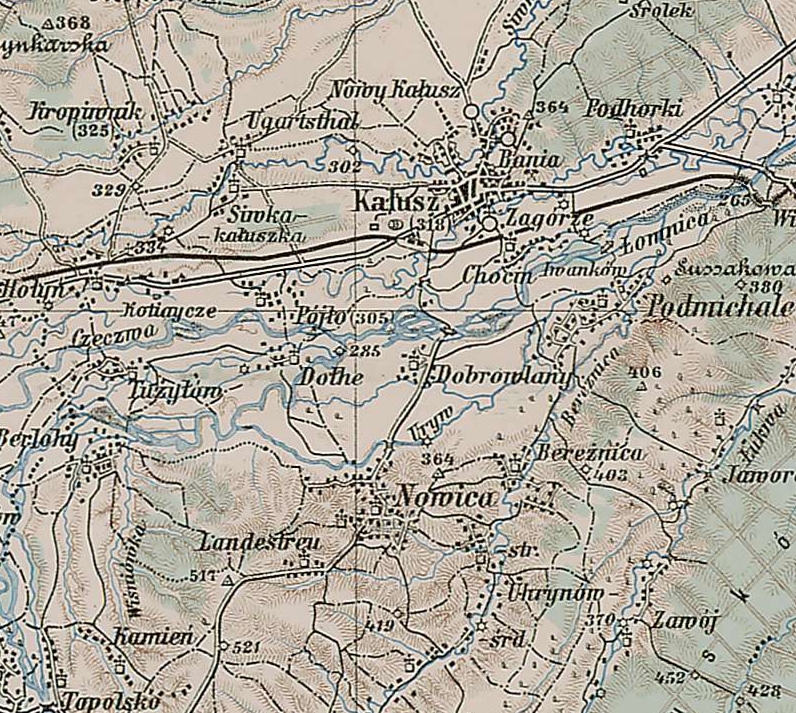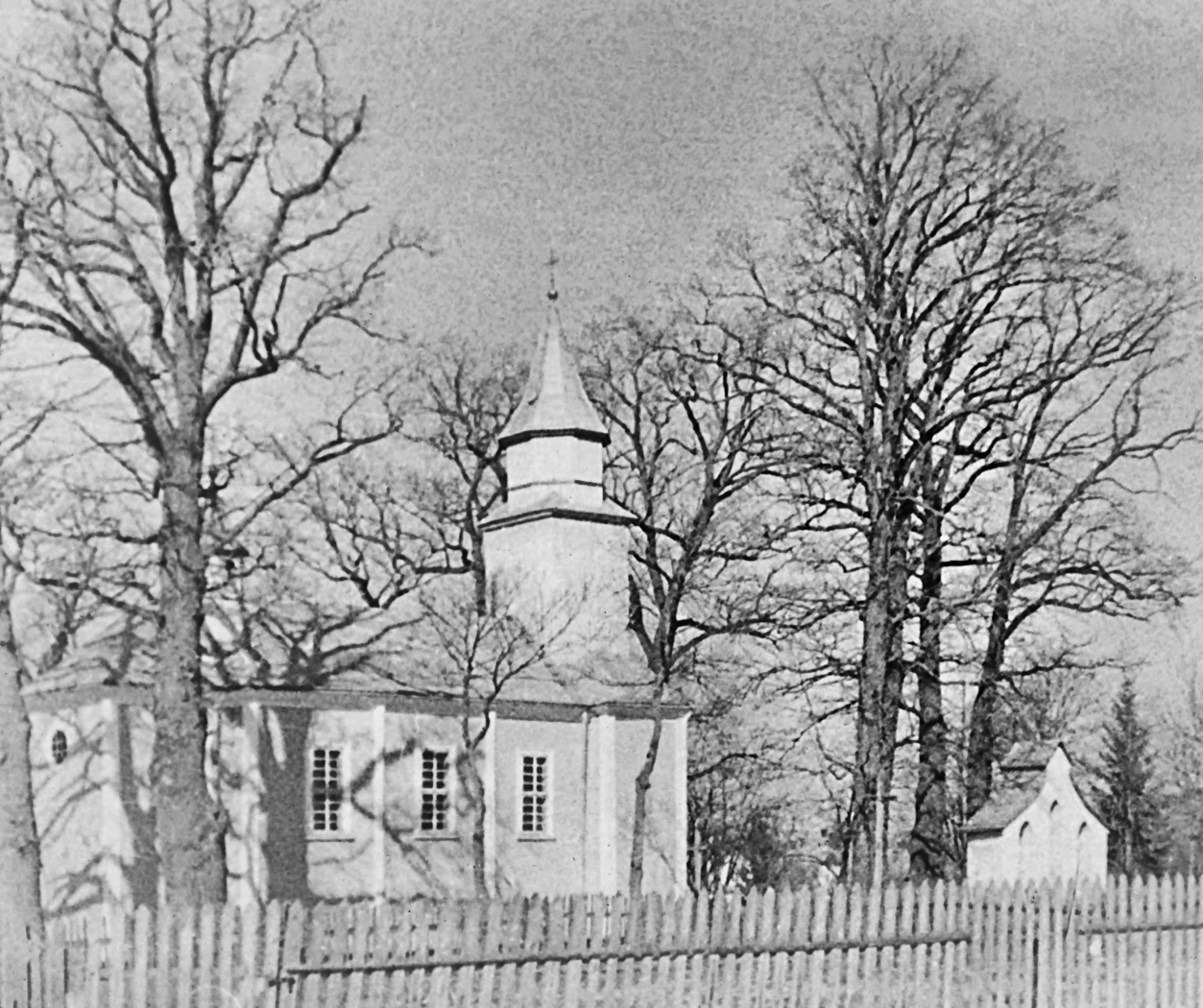|
Ugartsthal
Ugartsthal, a former German colony in the Kingdom of Galicia and Lodomeria which is today part of the village Sivka-Kaluska in Kalush Raion (Ivano-Frankivsk Oblast, Ukraine), is located west of Kalush. Description In the 19th century around the colony to the north laid Wierzchnia and Mościska, to the east Kalush, to the south Siwka, on the west - a village Kropiwnik. Through the centre of village flowed the Kropiwnik stream; through northern part flows Froniłów or Fornelów; left inflow of Kropiwnik Buildings of the village lie near the border of Siwka (Mt. 316 m.). The village composed one commune with Siwka. In 1880 there were 62 houses, 423 inhabitants in the commune, (43 Greek-Catholic, 3 Roman-Catholic, 365 Protestants, 12 Israelites; 14 Poles, 43 Rusins (Ruthenian, old name for the Ukrainians), 366 Germans). The Evangelical Parish in the place from 1784, the church from 1788 . To the parish belongs 3320 souls. Branches: Landestreu, Nowica, and Petranka. In the vil ... [...More Info...] [...Related Items...] OR: [Wikipedia] [Google] [Baidu] |
Josephine Colonization
The Josephine colonization (german: Josephinische kolonisation or Josephinisches siedlung, pl, kolonizacja józefińska) was a state-funded settlement campaign organised under the rule of Joseph II in the 1780s, in the then-new crownland of the Austrian Empire, Galicia, and to a lesser extent, in Bukovina. The colonization reinforced the societies of Galician and Bukovina Germans. History Austrian Empire endeavored to colonize, in a similar manner, lands wrestled from the Ottoman Empire during the 18th century, giving birth to, among others, the society of Danube Swabians. The first ethnically German and Protestant settlement on the territory that would later become Galicia emerged in the middle of the 18th century in Zalishchyky. Two years after the First Partition of Poland, namely in September 1774, Maria Theresa issued a patent allowing settlement of non-Protestant artisans and traders in Lemberg, Jarosław, Zamość (which was lost to Russia in 1809) and Zalishch ... [...More Info...] [...Related Items...] OR: [Wikipedia] [Google] [Baidu] |
Zelenyj Jar
Zelenyi Yar ( ua, Зелений Яр, german: Landestreu) is a village (''selo'') in Kalush Raion, Ivano-Frankivsk Oblast, in west Ukraine. It belongs to Novytsia rural hromada, one of the hromadas of Ukraine. The village was established in the course of Josephine colonization by Lutheran settlers in 1783. In 1789 it had 42 families. The local filial Lutheran church belonged to the parish of Ugartsthal. In the late 1930s the name was changed to ''Mazurówka''. In January 1940 the local German population was moved out (Heim ins Reich), later replaced by Ukrainians Ukrainians ( uk, Українці, Ukraintsi, ) are an East Slavic ethnic group native to Ukraine. They are the seventh-largest nation in Europe. The native language of the Ukrainians is Ukrainian. The majority of Ukrainians are Eastern Or .... References Zelenyj Jar {{IvanoFrankivsk-geo-stub ... [...More Info...] [...Related Items...] OR: [Wikipedia] [Google] [Baidu] |
Church In Ugartsthal Resize Resize
Church may refer to: Religion * Church (building), a building for Christian religious activities * Church (congregation), a local congregation of a Christian denomination * Church service, a formalized period of Christian communal worship * Christian denomination, a Christian organization with distinct doctrine and practice * Christian Church, either the collective body of all Christian believers, or early Christianity Places United Kingdom * Church (Liverpool ward), a Liverpool City Council ward * Church (Reading ward), a Reading Borough Council ward * Church (Sefton ward), a Metropolitan Borough of Sefton ward * Church, Lancashire, England United States * Church, Iowa, an unincorporated community * Church Lake, a lake in Minnesota Arts, entertainment, and media * ''Church magazine'', a pastoral theology magazine published by the National Pastoral Life Center Fictional entities * Church (''Red vs. Blue''), a fictional character in the video web series ''Red vs. Blue'' * Chu ... [...More Info...] [...Related Items...] OR: [Wikipedia] [Google] [Baidu] |
Galician Germans
The Galician Germans (german: Galiziendeutsche) were ethnic German population living in the Kingdom of Galicia and Lodomeria in the Austrian Empire, established in 1772 as a result of the First Partition of Poland, and after World War I in the four voivodeships of interwar Poland: Kraków, Lwów, Tarnopol, and Stanisławów. During World War II, part of the Galician Germans were moved out in January 1940 in the course of Heim ins Reich, the majority of the rest of them fled later in the years 1944–1945. History The first wave of ethnic Germans arrived in what would later be known as Galicia in the late Middle Ages (see Ostsiedlung). In part of the region the settlers were known as Walddeutsche. Most of them underwent Polonization at latest in the 18th century."Całkowita polonizacja ludności w omawianym regionach nastąpiła najpóźniej w XVIII w. .. p. 98, and "Eine völlige Polonisierung der Nachkommen der deutschen Ansiedler erfolgte im 18. Jahrhundert und trug zur Verstä ... [...More Info...] [...Related Items...] OR: [Wikipedia] [Google] [Baidu] |
Sołotwina
Solotvyn ( uk, Солотвин, pl, Sołotwina) is an urban-type settlement in Ivano-Frankivsk Raion of Ivano-Frankivsk Oblast, 40 km from Ivano-Frankivsk. Solotvyn hosts the administration of Solotvyn settlement hromada, one of the hromadas of Ukraine. Its estimated population was . Solotvyn is on the Bystrytsia of Solotvyn, the left of the two long headstreams of the Bystrytsia River (a tributary of the Dniester), at the foot of the Carpathian Mountains The Carpathian Mountains or Carpathians () are a range of mountains forming an arc across Central Europe. Roughly long, it is the third-longest European mountain range after the Urals at and the Scandinavian Mountains at . The range stretches .... In the seventeenth century it was named ''Krasnopil''. Until 18 July 2020, Solotvyn belonged to Bohorodchany Raion. The raion was abolished in July 2020 as part of the administrative reform of Ukraine, which reduced the number of raions of Ivano-Frankivsk Oblast to six ... [...More Info...] [...Related Items...] OR: [Wikipedia] [Google] [Baidu] |
Bohorodczany
Bohorodchany ( uk, Богородча́ни, translit=Bohorodčany, ) is an urban-type settlement in Ivano-Frankivsk Raion, Ivano-Frankivsk Oblast, several miles from Ivano-Frankivsk. It hosts the administration of Bohorodchany settlement hromada, one of the hromadas of Ukraine. Population: . History It is not known when the town was established, but it was first mentioned in 1441 as a property of certain Jan of Buczacz, the starost of Trembowla (today Terebovlia). Since the second half of the 15th century the local estate belonged to the Potocki family. In 1691 Konstancja Potocka née Truskolaska, widow of the owner of the village Dominik Potocki, established a Roman Catholic church and a parish there. In 1742 the wooden church was replaced with a more permanent construction, founded by Stanisław Kossakowski and devoted to the cult of Holy Mary. In 1765 the new church was donated to the Dominican Order, whose friars established a convent there. Later in the 18th century the t ... [...More Info...] [...Related Items...] OR: [Wikipedia] [Google] [Baidu] |
Ivano-Frankivsk
Ivano-Frankivsk ( uk, Іва́но-Франкі́вськ, translit=Iváno-Frankívśk ), formerly Stanyslaviv ( pl, Stanisławów ; german: Stanislau), is a city located in Western Ukraine. It is the administrative centre of Ivano-Frankivsk Oblast and Ivano-Frankivsk Raion. Ivano-Frankivsk hosts the administration of Ivano-Frankivsk urban hromada. Its population is Built in the mid-17th century as a fortress of the Polish Potocki family, Stanisławów was annexed to the Habsburg Empire during the First Partition of Poland in 1772, after which it became the property of the State within the Austrian Empire. The fortress was slowly transformed into one of the most prominent cities at the foothills of the Carpathian Mountains. After World War I, for several months, it served as a temporary capital of the West Ukrainian People's Republic. Following the Peace of Riga in 1921, Stanisławów became part of the Second Polish Republic. After the Soviet invasion of Poland at the o ... [...More Info...] [...Related Items...] OR: [Wikipedia] [Google] [Baidu] |
Dolyna
Dolyna ( uk, Доли́на, pl, Dolina, yi, דאלינע) is a city located in Kalush Raion of Ivano-Frankivsk Oblast (region) in south-western Ukraine. It hosts the administration of Dolyna urban hromada, one of the hromadas of Ukraine. Population: . In 2001, population was around 20,900. History The city's history reaches the 10th century, making it one of oldest in the region. By the 14th century Dolyna became renowned for its salt mine. In 1349 the city came under the rule of the Kingdom of Poland, where it remained until 1772 (see Partitions of Poland). In 1525 Dolyna, or Dolina, as it is called in Polish, was granted city rights under the Magdeburg law and the right to trade salt similar to that of Kolomyia. In 1740 in the city there was a riot of '' opryshky'' (Ukrainian rebels). In 1772 the city fell to Austrians and in 1791 it lost its status. During the second half of the 19th century a railroad line linking Stryi with Stanislaviv was led through the city. By the ... [...More Info...] [...Related Items...] OR: [Wikipedia] [Google] [Baidu] |
Pastor
A pastor (abbreviated as "Pr" or "Ptr" , or "Ps" ) is the leader of a Christian congregation who also gives advice and counsel to people from the community or congregation. In Lutheranism, Catholicism, Eastern Orthodoxy, Oriental Orthodoxy and Anglicanism, pastors are always ordained. In Methodism, pastors may be either licensed or ordained. Pastors are to act like shepherds by caring for the flock, and this care includes teaching. The New Testament typically uses the words "bishops" ( Acts 20:28) and "presbyter" ( 1 Peter 5:1) to indicate the ordained leadership in early Christianity. Likewise, Peter instructs these particular servants to "act like shepherds" as they "oversee" the flock of God ( 1 Peter 5:2). The words "bishop" and "presbyter" were sometimes used in an interchangeable way, such as in Titus 1:5-6. However, there is ongoing dispute between branches of Christianity over whether there are two ordained classes (presbyters and deacons) or three (bishops, priests ... [...More Info...] [...Related Items...] OR: [Wikipedia] [Google] [Baidu] |
Poland
Poland, officially the Republic of Poland, , is a country in Central Europe. Poland is divided into Voivodeships of Poland, sixteen voivodeships and is the fifth most populous member state of the European Union (EU), with over 38 million people, and the List of European countries by area, seventh largest EU country, covering a combined area of . It extends from the Baltic Sea in the north to the Sudetes and Carpathian Mountains in the south, bordering seven countries. The territory is characterised by a varied landscape, diverse ecosystems, and Temperate climate, temperate transitional climate. The capital and List of cities and towns in Poland, largest city is Warsaw; other major cities include Kraków, Wrocław, Łódź, Poznań, and Gdańsk. Prehistory and protohistory of Poland, Humans have been present on Polish soil since the Lower Paleolithic, with continuous settlement since the end of the Last Glacial Period over 12,000 years ago. Culturally diverse throughout ... [...More Info...] [...Related Items...] OR: [Wikipedia] [Google] [Baidu] |
Moravia
Moravia ( , also , ; cs, Morava ; german: link=yes, Mähren ; pl, Morawy ; szl, Morawa; la, Moravia) is a historical region in the east of the Czech Republic and one of three historical Czech lands, with Bohemia and Czech Silesia. The medieval and early modern Margraviate of Moravia was a crown land of the Lands of the Bohemian Crown from 1348 to 1918, an imperial state of the Holy Roman Empire from 1004 to 1806, a crown land of the Austrian Empire from 1804 to 1867, and a part of Austria-Hungary from 1867 to 1918. Moravia was one of the five lands of Czechoslovakia founded in 1918. In 1928 it was merged with Czech Silesia, and then dissolved in 1949 during the abolition of the land system following the communist coup d'état. Its area of 22,623.41 km2 is home to more than 3 million people. The people are historically named Moravians, a subgroup of Czechs, the other group being called Bohemians. Moravia also had been home of a large German-speaking p ... [...More Info...] [...Related Items...] OR: [Wikipedia] [Google] [Baidu] |


_-_1880_Podkarpacie.jpg)

.jpg)